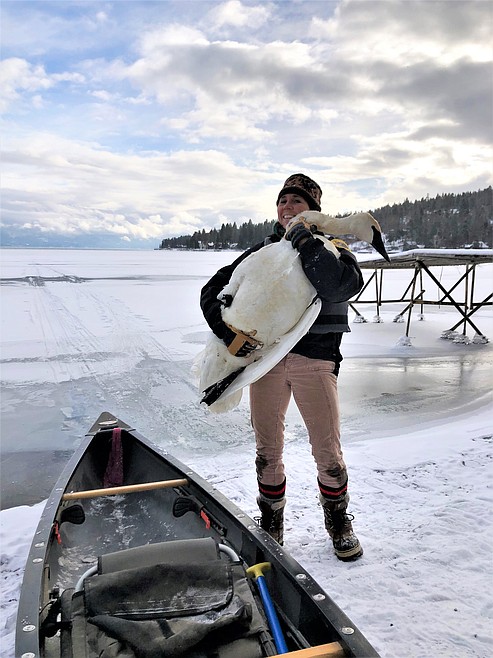Despite best efforts, swan dies from lead poisoning
Hungry Horse News
Last week, an adult trumpeter swan was found lethargic on the ice of Somers Bay of Flathead Lake, something was obviously wrong with the majestic bird.
Montana Fish, Wildlife and Parks biologists Jessy Coltrane and Wendy Cole along with help from residents Wendy and Tanner Johnson, went out onto the thin ice with a canoe, lifejackets, and lots of rope. Coltrane safely skimmed across roughly 150 feet of patchy ice and retrieved the swan with a net. She then carefully hauled the bird back to shore with the help of the Johnsons, local residents who initially reported the bird’s distress.
The swan was taken to the Montana Wild Wings Recovery Center for treatment, as it had obvious signs of lead poisoning.
“It’s lead levels were so high, our machine couldn’t read it,” executive director Beth Watne said.
Lead levels are tested through a small blood sample.
Watne was out of town during the rescue, but volunteers at the center immediately began chelation therapy — a therapy that removes lead from the blood — on the bird, which includes injections of Calcium EDTA. The medicine binds to the lead where it can be passed through the urinary tract.
The swan made it through the night, but unfortunately died the next day, Watne said.
A subsequent X-ray found lead shot in its gut, she said.
Lead poisoning continues to be a problem in birds, Watne said.
This year, she said she also had four bald eagles die of lead poisoning.
In the case of eagles, they typically pick up lead from eating at gut piles of game shot by hunters, where there are still lead fragments in the meat.
In the case of the swan, it likely picked up the lead while feeding on the bottom of the lake. Though lead shot has been banned for waterfowl hunting for decades, the shot from years ago still persists in the environment. It’s a metal and it doesn’t break down. Lead is still also commonly used in fishing lures.
What would help in the case of eagles and other scavengers, Watne notes, is for hunters to use non-toxic bullets, like copper.
California in 2019 banned the use of lead bullets for hunting, in order to protect California condors and other birds. It was the first state to do so.
But copper bullets are more expensive and some hunters claim they aren’t as effective, though recent tests appear to show otherwise.
Lead debate aside, Watne said the number of birds being treated at her facility, not just for lead, but a host of other injuries, was way up this year.
Volunteers typically treat 80 to 90 birds a year, she said. This year they treated 117 birds.
“Each year, it’s busier and busier,” she said.
Her husband Bob Watne, recently added 18 more cages and a 100-foot long flight barn so birds can get their proverbial wings back before being released.
As far as lead treatment, the odds are 50-50 Watne said.
“It depends on how quickly you can get (to the bird),” she said.
Some birds may be sick, but can still fly, so catching them is almost impossible.
A bird with severe lead poisoning will be lethargic, with its head down and clenched limbs, looking almost as if it’s drunk.
It’s almost impossible to predict if a bird will recover from lead poisoning, Watne noted. A bird might come in feisty and die two days later. A bird that looks awful may recover.
Both bald eagles and trumpeter swans have recovered from the brink of extinction in the Lower 48. Eagles were decimated by the use of the pesticide DDT. The DDT went through the food chain into fish, which the birds ate. It caused the birds’ shells to be too thin and the nests would fail.
DDT was banned and the eagle population eventually recovered.
The trumpeter swan was nearly hunted to extinction as its feathers were used for hats in the early 1900s. Passage of the Migratory Bird Act banned trumpeter swan hunting and efforts to breed them in captivity and then release them in the wild have also proven successful.
Folks interested in supporting the recovery center and learning more can visit its website at: https://www.wildwingsrecovery.org

